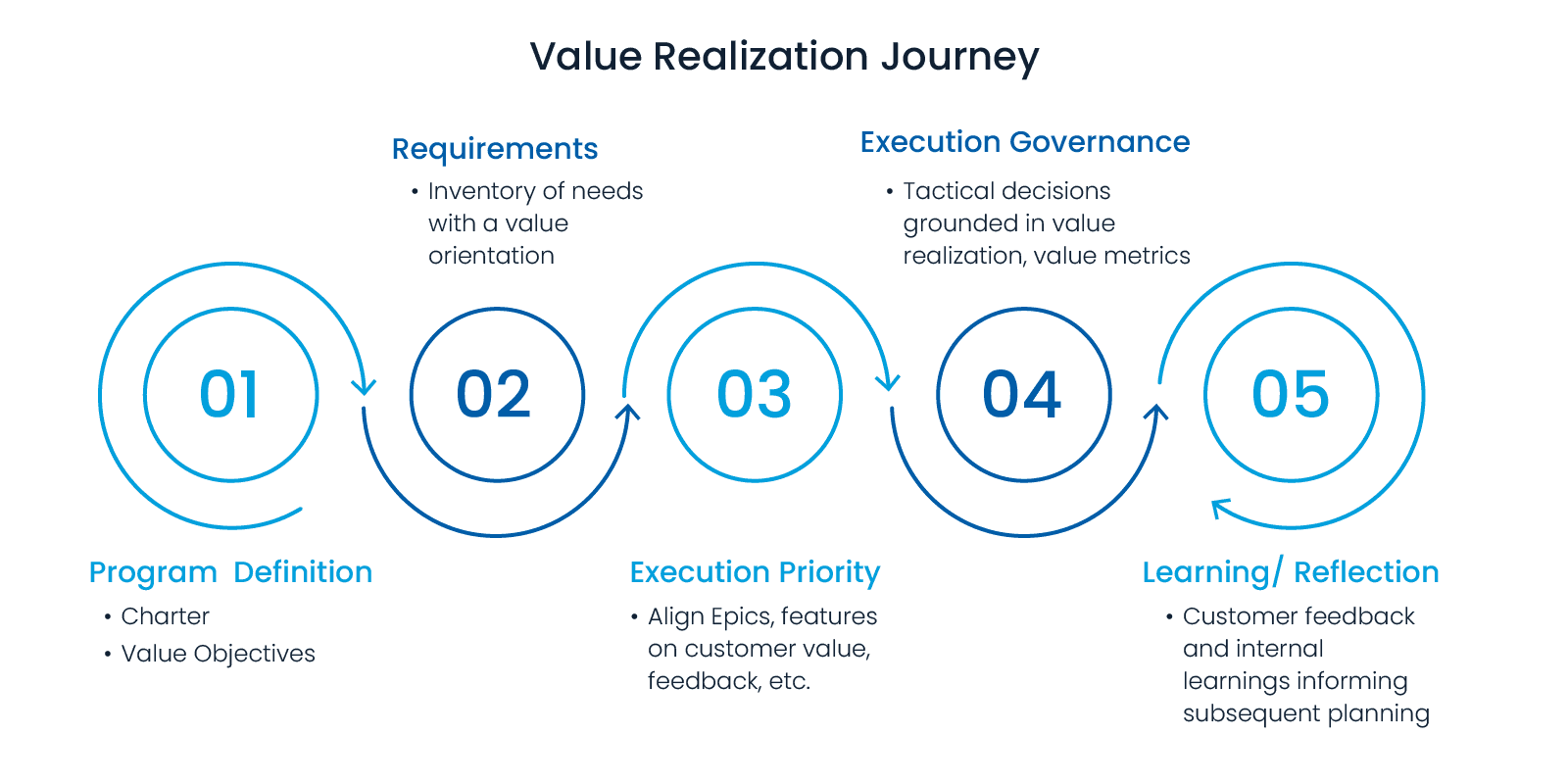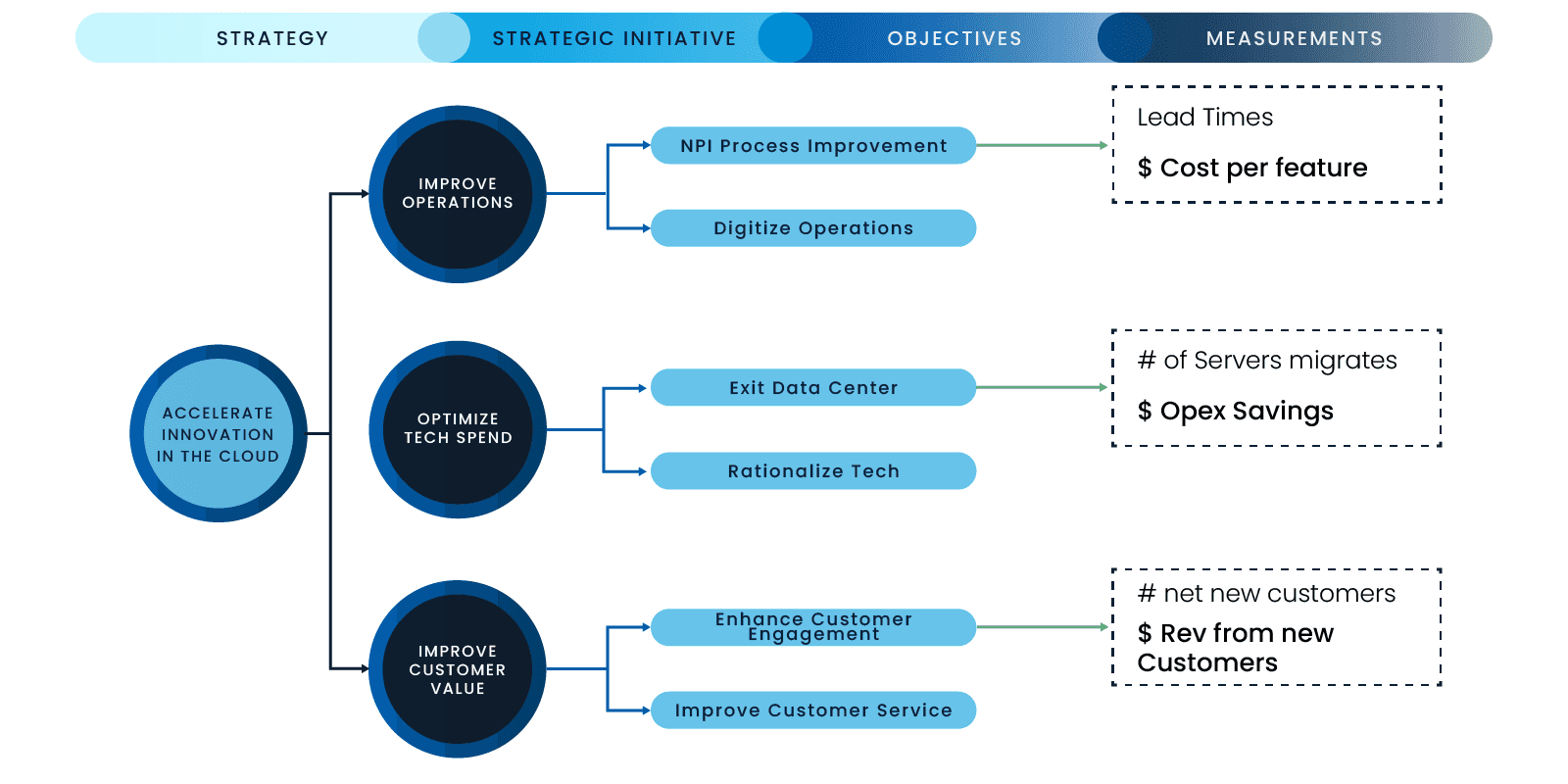REALIZING VALUE WITHIN DIGITAL TRANSFORMATION

The driving force behind any transformation strategy is building competitive advantage. And in order to do so, organizations must be laser-focused on the creation of value – for customers, stakeholders, employees, and for the enterprise as a whole. However, it is not enough to simply point to the stated desired outcomes of a transformation program and call it the value of an initiative. Rather, it is critical to track value across the entire transformation journey, which has three major milestones:
- Developing a business case for the transformation
- Setting a strategy that identifies the activities necessary for realizing the business case
- Creating a mechanism to measure success during execution
This all seems perfectly logical, so why is it that organizations find it difficult to track value through their investments and prevent transformation initiatives from dying on the vine? In this article, we’ll explore the prominent challenges related to value realization, the critical (and evolving) role of program management, and the best practices for measuring value throughout the lifecycle of a transformation.
Identify Roadblocks to Value Realization
While identifying value at a single point in time is generally a less cumbersome task, enterprises frequently struggle with keeping the value in their sights over the course of a transformation engagement. Some of the most common challenges with tracking value over time include:
- Long-term initiatives that lack sustained prioritization of project value realization – after the initial focus on value tracking, attention given to value declines over time with a focus on pure project execution and project results
- Operating models that are not aligned with value creation
- A lack of solid representation of value creation during project execution
- Missing frameworks for tracking and evaluating investments (misaligned metrics)
- Project delays that shift team focus from value to budget
What is the commonality between all of these challenges? They are typically handled by a traditional program management function. The problem? That may not be enough anymore.
Redefine Program Management Responsibilities
A program management office (PMO) brings the focus and structure needed to manage workstreams and activities. Why, then, isn’t a traditional PMO enough to support value realization through these transformative efforts? First, let’s look at the present roles and responsibilities of most PMOs:
- Developing a program roadmap and charter
- Establishing governance functions
- Defining risk, financial, and resource management processes and metrics
- Establishing program controls and KPIs/KRIs
- Monitoring the execution via established objectives, baselines, and metrics
- Providing reporting to stakeholders and leadership on progress
A PMO is essential to the success of any large-scale transformation but needs to be augmented with practices designed to track value as well. By integrating value realization into the program management function, organizations can achieve the business alignment needed to make not just the strategic decisions, but also the tactical ones that get made through the execution phase. The program governance function will, as a result, have a higher-level view of the business objectives rather than a perspective driven solely by program compliance. However, this cannot be an isolated effort. From program inception through completion, the value perspective must remain present to continuously support both strategic alignment with the transformation objectives as well as tactical decision making.

Techniques for Finding the Sources of Value
The essence of any digital transformation can be boiled down to three imperatives: innovate products and services, build new customer experiences, and optimize how they operate. These tasks are then broken down into a series of initiatives/programs. While organizations typically find it useful to build a core set of capabilities by function and/or department, value creation must cut right across various functions, and requires multi-functional collaboration.
A value chain (macro) or value stream (micro) perspective is a more helpful way to look at the specific stages at which value is created by various parts of the organization. It allows us to create benchmarks, set targets, and measure them for each set of organizational functions/groups. These targets can be better understood by the groups involved in a particular value stage as opposed to program-level metrics, which may not tie very well into functions/groups that contribute to very specific stages in the value chain. Further, a value chain or value stream perspective is more closely aligned with how value is being created regardless of what part of the organization is involved in the activities.
A useful way to track value creation from a macro level down to the point of execution is to visualize the breakdown as a tree. The visual below serves as an example of how a value tree for one of your strategic initiatives should look:

By breaking out a strategy into specific initiatives, objectives, and ways to measure them, it becomes easier for everyone else to grasp how value is being created across the program. This level of clarity is not only helpful for reporting and tracking purposes, but also can be integral to the ongoing execution of various workstreams.
Treat KPIs as Decision-Making Tools
It’s critical for managers and leaders in every function to question whether the day-to-day decisions they are making are adding or diminishing value, and the best way to do this is through the use of KPIs (key performance indicators). Well-designed KPIs—apart from marking successes and failures throughout execution—help with agile decision making. Most companies treat KPIs as simple accounting and reporting mechanisms, but not as decision-making tools. This is the wrong approach, as having KPIs woven into day-to-day decision making helps frame strategic value creation as the central purpose of all activities.
Factor Value Creation into Financial Decisions
A leaner, more agile financing/budgeting process will also help with making better investment decisions along the way. The traditional approach is to have a ‘program’ orientation with a ‘fixed’ mindset on resources and assets. However, in order to ensure that there is an ongoing value orientation, the financing of transformation programs needs to continuously track value metrics and inform additional funding decisions.
What’s more, transformation teams accumulate knowledge through each of the value streams, which helps with both strategic decision making and finance. Budgeting by value stream focuses investments on value creation and not just the inputs (resources and assets) related to a project. Thus, teams that are closer to the value creation are in a better position to make decisions (with some oversight) than a centralized authority whose limited perspective may impede the required pace of progress.
While a value oriented PMO and a value stream perspective are both essential, we also need an operating construct where people organize themselves around not just skills or departments, but around how value is created at every stage. The benefits of this value stream orientation include:
- Less frequent hand-offs between departments due to cross-functional teams
- Teams that outlast projects because they are organized around products and value creation (not around projects)
- Faster learning and shorter time-to-market
- Higher quality and better productivity
- Leaner development and budgeting methods
Value Orientation is Central to Successful Digital Transformation Initiatives
By employing this value-oriented approach from the business case-building stage all the way through to program definition and execution, organizations will undoubtedly begin to discover previously unidentified value sources. Further, the subsequent development of a framework to align tracking and decision-making will enable the enterprise to establish lean methods for funding the transformation journey. And last, but certainly not least, organizing people and teams around value creation improves the rate of project success and helps to enhance customer satisfaction overall.
